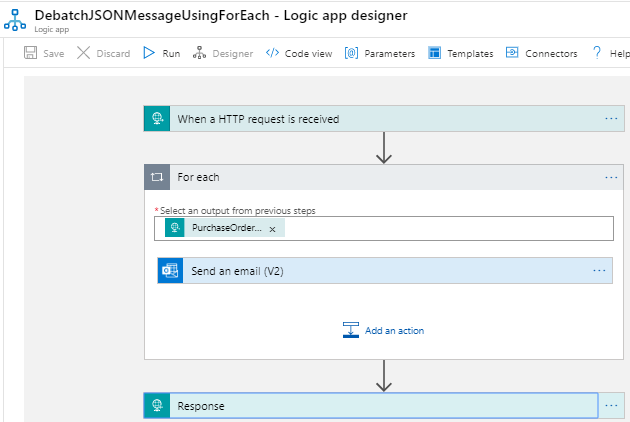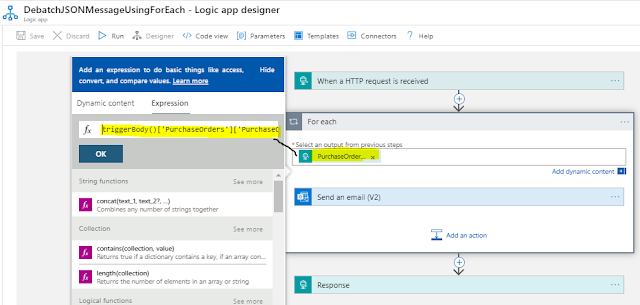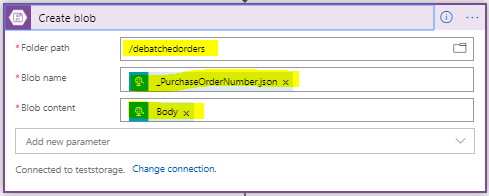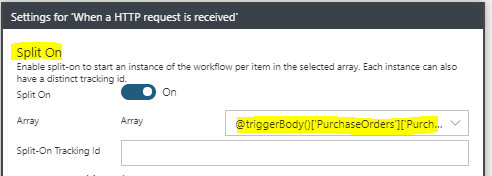{tocify} $title={Table of Contents}
Create Http based Logic app
In Azure portal create new instance of Logic App, once ready - in designer
Add http trigger, followed by ForEach and Response Action
It is in For each control where we specify the path of the repeating node (which is to be splitted)
Create Http based Logic app
In Logic app Designer add HTTP trigger followed by Create blob action (just keeping it simple :) )
In Create blob action, I have specified the location where the blob is to be create with what name(PurchaseOrderNumber property in coming JSON) and the content of it(Whatever is received in trigger)
We need to set splitOn property on trigger, but no where it is visible -- Not able to understand why Microsoft has not provided.
No problem, we can still do it by going to Logic app code view, and under triggers, add splitOn property with value as path expression (same path is used as in For each above)
Save it, and now you should be able to see in Designer view as well in trigger Settings
Setting this property forces Logic App engine to create equivalent number of instances as that of number of repeating nodes, so if there are three repeating nodes in message posted to this logic app, then 3 different instance of this logic app will be instantiated.
Note: You can't use SplitOn with a synchronous response pattern , read Error related to this
-- The workflow with 'Response' action type should not have triggers with 'splitOn' property
Using Postman, sent a request(JSON PurchaseOrders) having three PurchaseOrder property in it to both the logic app
Three emails were sent by this logic app
Three blob were created in debatchedOrders container by three logic app instance
Note: In both the logic app above message debatching happens, but in second approach the process/workflow also gets splitted (it scales out based on splitted messages by spinning new instances of itself). However in first logic app single instance does all the work.
Introduction
In last post Debatching(Splitting) XML Message in Logic Apps - ForEach and SplitOn we understood about Splitter pattern and how to use it to split/debatch messages.
In this post we will see how to debatch/split JSON message
Basic difference between XML (Extensible Markup Language) and JSON (JavaScript Object Notation) is - xml is a markup language and uses tag (that's why its heavier) structure to represent data items whereas JSON is a way of representing objects.
JSON supports only UTF-8 encoding whereas XML supports many type of encoding
{
"PurchaseOrders": {
"PurchaseOrder": [
{
"Address": [
{
"Name": "Ellen Adams",
"Street": "123 Maple Street",
"City": "Mill Valley",
"State": "CA",
"Zip": "10999",
"Country": "USA",
"_Type": "Shipping"
}
],
"DeliveryNotes": "Please leave packages in shed by driveway.",
"Items": {
"Item": [
{
"ProductName": "Lawnmower",
"Quantity": "1",
"USPrice": "148.95",
"Comment": "Confirm this is electric",
"_PartNumber": "872-AA"
},
{
"ProductName": "Baby Monitor",
"Quantity": "2",
"USPrice": "39.98",
"ShipDate": "1999-05-21",
"_PartNumber": "926-AA"
}
]
},
"_OrderDate": "1999-10-20",
"_PurchaseOrderNumber": "99503"
},
{
"Address": [
{
"Name": "Cristian Osorio",
"Street": "456 Main Street",
"City": "Buffalo",
"State": "NY",
"Zip": "98112",
"Country": "USA",
"_Type": "Shipping"
}
],
"DeliveryNotes": "Please notify me before shipping.",
"Items": {
"Item": {
"ProductName": "Power Supply",
"Quantity": "1",
"USPrice": "45.99",
"_PartNumber": "456-NM"
}
},
"_OrderDate": "1999-10-22",
"_PurchaseOrderNumber": "99505"
},
{
"Address": [
{
"Name": "Jessica Arnold",
"Street": "4055 Madison Ave",
"City": "Seattle",
"State": "WA",
"Zip": "98112",
"Country": "USA",
"_Type": "Shipping"
}
],
"Items": {
"Item": [
{
"ProductName": "Computer Keyboard",
"Quantity": "1",
"USPrice": "29.99",
"_PartNumber": "898-AZ"
},
{
"ProductName": "Wireless Mouse",
"Quantity": "1",
"USPrice": "14.99",
"_PartNumber": "898-AM"
}
]
},
"_OrderDate": "1999-10-22",
"_PurchaseOrderNumber": "99504"
}
]
}
}
In this post we will see how to debatch/split JSON message
Basic difference between XML (Extensible Markup Language) and JSON (JavaScript Object Notation) is - xml is a markup language and uses tag (that's why its heavier) structure to represent data items whereas JSON is a way of representing objects.
JSON supports only UTF-8 encoding whereas XML supports many type of encoding
Scenario
Say we want to debatch/split PurchaseOrders json message having multiple Purchase Order in it
"PurchaseOrders": {
"PurchaseOrder": [
{
"Address": [
{
"Name": "Ellen Adams",
"Street": "123 Maple Street",
"City": "Mill Valley",
"State": "CA",
"Zip": "10999",
"Country": "USA",
"_Type": "Shipping"
}
],
"DeliveryNotes": "Please leave packages in shed by driveway.",
"Items": {
"Item": [
{
"ProductName": "Lawnmower",
"Quantity": "1",
"USPrice": "148.95",
"Comment": "Confirm this is electric",
"_PartNumber": "872-AA"
},
{
"ProductName": "Baby Monitor",
"Quantity": "2",
"USPrice": "39.98",
"ShipDate": "1999-05-21",
"_PartNumber": "926-AA"
}
]
},
"_OrderDate": "1999-10-20",
"_PurchaseOrderNumber": "99503"
},
{
"Address": [
{
"Name": "Cristian Osorio",
"Street": "456 Main Street",
"City": "Buffalo",
"State": "NY",
"Zip": "98112",
"Country": "USA",
"_Type": "Shipping"
}
],
"DeliveryNotes": "Please notify me before shipping.",
"Items": {
"Item": {
"ProductName": "Power Supply",
"Quantity": "1",
"USPrice": "45.99",
"_PartNumber": "456-NM"
}
},
"_OrderDate": "1999-10-22",
"_PurchaseOrderNumber": "99505"
},
{
"Address": [
{
"Name": "Jessica Arnold",
"Street": "4055 Madison Ave",
"City": "Seattle",
"State": "WA",
"Zip": "98112",
"Country": "USA",
"_Type": "Shipping"
}
],
"Items": {
"Item": [
{
"ProductName": "Computer Keyboard",
"Quantity": "1",
"USPrice": "29.99",
"_PartNumber": "898-AZ"
},
{
"ProductName": "Wireless Mouse",
"Quantity": "1",
"USPrice": "14.99",
"_PartNumber": "898-AM"
}
]
},
"_OrderDate": "1999-10-22",
"_PurchaseOrderNumber": "99504"
}
]
}
}
Steps to implement Splitter/Debatching Pattern in Logic App
Splitting using For each control
In Azure portal create new instance of Logic App, once ready - in designer
Add http trigger, followed by ForEach and Response Action
It is in For each control where we specify the path of the repeating node (which is to be splitted)
triggerBody()['PurchaseOrders']['PurchaseOrder']
Using path above - we are asking to traverse through the triggerBody and look out of PurchaseOrder property and if found then add entry in For each array.(All occurrence of PurchaseOrder property are added).
Now we add next steps within For each by using Add an action, here I have added Send an email step. So Send an email will be executed based on items in For each array, if there are 3 items then 3 times email will be sent out.
Note : The default behavior of For each loop is to run in parallel and each iteration in it runs in different
thread, however it can be made to run in sequential form by setting its Degree of Parallelism to 1.
Another example using For each debatching -- Inserting Multiple Records In On Prem SQL Using Logic App
thread, however it can be made to run in sequential form by setting its Degree of Parallelism to 1.
Another example using For each debatching -- Inserting Multiple Records In On Prem SQL Using Logic App
Splitting using SplitOn property on trigger
Create Http based Logic app
In Logic app Designer add HTTP trigger followed by Create blob action (just keeping it simple :) )
We need to set splitOn property on trigger, but no where it is visible -- Not able to understand why Microsoft has not provided.
No problem, we can still do it by going to Logic app code view, and under triggers, add splitOn property with value as path expression (same path is used as in For each above)
Save it, and now you should be able to see in Designer view as well in trigger Settings
Setting this property forces Logic App engine to create equivalent number of instances as that of number of repeating nodes, so if there are three repeating nodes in message posted to this logic app, then 3 different instance of this logic app will be instantiated.
Note: You can't use SplitOn with a synchronous response pattern , read Error related to this
-- The workflow with 'Response' action type should not have triggers with 'splitOn' property
Testing
Using Postman, sent a request(JSON PurchaseOrders) having three PurchaseOrder property in it to both the logic app
Logic App run history with Foreach control
Three emails were sent by this logic app
Logic App run history with SplitOn property on trigger
Three blob were created in debatchedOrders container by three logic app instance
If you have questions or suggestions, feel free to do in comments section below !!!
Do share if you find this helpful .......
Knowledge Sharing is Caring !!!!!!
Learn More about Logic App
- How to configure Logic App Standard workflow behind Azure APIM
- How to Query Azure Table storage from Logic App | How to filter results of Azure Table storage from Logic App
- Understanding expressions in Logic Apps | Frequently used expressions in Logic Apps | What is expressions in Logic App
- How to use Logic app Run History | How to troubleshoot Logic App workflow execution
- Logic App and Slack - Sending messages to slack channel | Logic app and slack integration | Connecting Logic App to Slack channel
- How to access Application settings fields value from Logic app Standard workflow | Using Application settings as configuration store for Logic app standard workflow
- Developing Logic app standard workflow which uses Map locally and deploying to Azure
- Developing Logic App Standard Workflow Using Visual Studio Code | Create Logic App Standard Workflow Using Visual Studio Code
- Logic App - Xml to Json using Liquid Map | Append in Liquid Map
- How to use Azure Event Grid Custom Topic | Publishing and Subscribing from Azure Event Grid Custom Topic using Logic App
- Using Azure Storage Account Table as Config Store for Logic Apps | How to read and write from Logic App to Azure Storage Account Table
- Get Logic App Name in Logic App
- Difference between Logic App Consumption and Logic App Standard
- Getting Started with Logic App Standard | Overview of Logic App Standard | Basics of Logic App Standard
- How to find count of Logic App executions using Azure Portal
- Azure Functions vs Azure Logic App | Difference between Azure Functions and Azure Logic App
- Getting started with Logic App : Liquid Map | Using Liquid template in Logic app
- How to get actual error message of Scope in Logic App | Exception Handling in Logic app
- Interview questions and answers on Logic Apps | Interview questions for azure logic app developers
- How to execute Stored Procedure in Logic App | How to connect to SQL in Logic App
- How to get current date in logic app | How to format date time in Logic App
- BizTalk Developer getting started with Logic App
- Getting Started with Logic Apps - Fundamentals
- Getting Started with Logic Apps - Enterprise Application Integration
- Getting Started with Logic Apps - AS2
- Getting Started with Logic Apps - EDI X12 Fundamentals
- Getting Started with Logic Apps - XML to EDI X12
- Getting Started with Logic Apps - EDI X12 to XML
- Getting Started with Logic Apps - What happened to the Request?
- Inserting Multiple Records In On Prem SQL Using Logic App
- Inserting data in On Premises SQL Database using Logic Apps
- Installing and Configuring On Premises Data Gateway - By adding user to Active Directory
- XML Batching(Aggregation) in Logic App
- Batching(Aggregating) messages in Logic App
- Debatching(Splitting) JSON Message in Logic Apps - ForEach and SplitOn
- Debatching(Splitting) XML Message in Logic Apps - ForEach and SplitOn
- Securing Logic App with Azure Active Directory authentication
- Removing ns0: prefix from xml output from BizTalk/Logic app XSLT map
- Using Managed Identity in Logic Apps for Calling Active Directory Secured Function App
- Logic Apps : Fetching ISA and GS Segment Values From Interchange Envelope and Mapping
- Logic Apps : For Each Inside a For Each - Fetching values from field in an array inside an array
- How to configure Logic App Standard workflow behind Azure APIM
- How to Query Azure Table storage from Logic App | How to filter results of Azure Table storage from Logic App
- Understanding expressions in Logic Apps | Frequently used expressions in Logic Apps | What is expressions in Logic App
- How to use Logic app Run History | How to troubleshoot Logic App workflow execution
- Logic App and Slack - Sending messages to slack channel | Logic app and slack integration | Connecting Logic App to Slack channel
- How to access Application settings fields value from Logic app Standard workflow | Using Application settings as configuration store for Logic app standard workflow
- Developing Logic app standard workflow which uses Map locally and deploying to Azure
- Developing Logic App Standard Workflow Using Visual Studio Code | Create Logic App Standard Workflow Using Visual Studio Code
- Logic App - Xml to Json using Liquid Map | Append in Liquid Map
- How to use Azure Event Grid Custom Topic | Publishing and Subscribing from Azure Event Grid Custom Topic using Logic App
- Using Azure Storage Account Table as Config Store for Logic Apps | How to read and write from Logic App to Azure Storage Account Table
- Get Logic App Name in Logic App
- Difference between Logic App Consumption and Logic App Standard
- Getting Started with Logic App Standard | Overview of Logic App Standard | Basics of Logic App Standard
- How to find count of Logic App executions using Azure Portal
- Azure Functions vs Azure Logic App | Difference between Azure Functions and Azure Logic App
- Getting started with Logic App : Liquid Map | Using Liquid template in Logic app
- How to get actual error message of Scope in Logic App | Exception Handling in Logic app
- Interview questions and answers on Logic Apps | Interview questions for azure logic app developers
- How to execute Stored Procedure in Logic App | How to connect to SQL in Logic App
- How to get current date in logic app | How to format date time in Logic App
- BizTalk Developer getting started with Logic App
- Getting Started with Logic Apps - Fundamentals
- Getting Started with Logic Apps - Enterprise Application Integration
- Getting Started with Logic Apps - AS2
- Getting Started with Logic Apps - EDI X12 Fundamentals
- Getting Started with Logic Apps - XML to EDI X12
- Getting Started with Logic Apps - EDI X12 to XML
- Getting Started with Logic Apps - What happened to the Request?
- Inserting Multiple Records In On Prem SQL Using Logic App
- Inserting data in On Premises SQL Database using Logic Apps
- Installing and Configuring On Premises Data Gateway - By adding user to Active Directory
- XML Batching(Aggregation) in Logic App
- Batching(Aggregating) messages in Logic App
- Debatching(Splitting) JSON Message in Logic Apps - ForEach and SplitOn
- Debatching(Splitting) XML Message in Logic Apps - ForEach and SplitOn
- Securing Logic App with Azure Active Directory authentication
- Removing ns0: prefix from xml output from BizTalk/Logic app XSLT map
- Using Managed Identity in Logic Apps for Calling Active Directory Secured Function App
- Logic Apps : Fetching ISA and GS Segment Values From Interchange Envelope and Mapping
- Logic Apps : For Each Inside a For Each - Fetching values from field in an array inside an array








